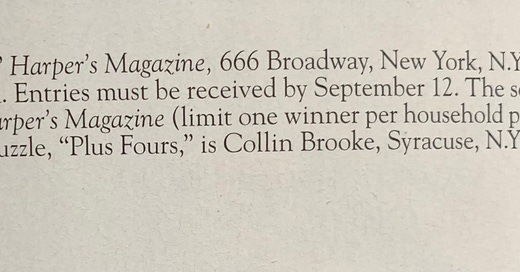The single longest media relationship of my life is my subscription to Harper’s magazine. I’ve enjoyed their long-form journalism, the Harper’s Index, their short stories, et al., but the primary reason that I’ve subscribed for so long is the cryptic crossword in the back of each issue.
I first started doing the Sunday crossword from the Chicago Tribune with my grandmother when I was in elementary school, not that I was especially good at it at the time. By the time I was in high school, I was probably able to actually do it with her. And I enjoyed them enough that I’d buy books of crosswords. I got into the NYT crossword eventually—a framed copy of the NYT crossword from the day I was born is on the wall of my office. But cryptic crosswords are a slightly different breed.
Each clue is its own puzzle, and the puzzles themselves often have some sort of macro theme to be solved. The New Yorker has a nice example page explaining generally how cryptic clues work. The thing that’s always appealed to me about cryptics is the fluidity that they require of one’s relationship to language. The folks who are most successful at regular crosswords often have an encyclopedic knowledge of words themselves (and their definitions)—they are human databases, able to access that knowledge quickly and confidently.
But cryptic clues often defy that kind of thinking:
For this clue, you have to figure out that “pan” (put down) plus DA’s (prosecutor’s) allows you to come up with “pandas” (animals, e.g.). And every single clue requires this type of creative thinking about language: anagrams, one word placed inside of another, homophones, and more. One portion of the clue is always a synonym (animals - pandas), but it’s rarely easy to infer an answer from the synonym itself.
In a given year, I might solve 5-7 of that year’s 12 puzzles—sometimes I’m a little sharper, sometimes less. But one of the things that Harper’s does is that you can send them the completed puzzle by a certain deadline (usually about three weeks). If your submission meets the deadline, and yours is the first they open, and you’ve done it correctly, you get a free year of subscription to the magazine.
Which is important to know here, because in the August issue of Harper’s, you’ll find the following on page 79:
That’s right. After doing these things for 30-odd years, and sending in my solutions, I finally won! This will almost certainly be the only time in my life where I appear in Harper’s, so forgive me if I celebrate a little…





